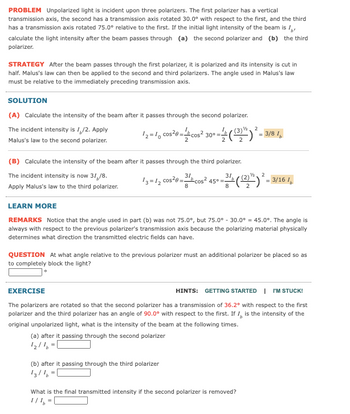
College Physics
11th Edition
ISBN: 9781305952300
Author: Raymond A. Serway, Chris Vuille
Publisher: Cengage Learning
expand_more
expand_more
format_list_bulleted
Question
please solve this problem

Transcribed Image Text:PROBLEM Unpolarized light is incident upon three polarizers. The first polarizer has a vertical
transmission axis, the second has a transmission axis rotated 30.0° with respect to the first, and the third
has a transmission axis rotated 75.0° relative to the first. If the initial light intensity of the beam is I
calculate the light intensity after the beam passes through (a) the second polarizer and (b) the third
polarizer.
STRATEGY After the beam passes through the first polarizer, it is polarized and its intensity is cut in
half. Malus's law can then be applied to the second and third polarizers. The angle used in Malus's law
must be relative to the immediately preceding transmission axis.
SOLUTION
(A) Calculate the intensity of the beam after it passes through the second polarizer.
The incident intensity is 1/2. Apply
Malus's law to the second polarizer.
2
12 = 10 cos²0=cos² 30º =((32") ² = 3/8 1
2
(B) Calculate the intensity of the beam after it passes through the third polarizer.
The incident intensity is now 31,/8.
31,
2
13=12 cos²0=31cos² 45⁰ m²
3/4 ((2) ²)² = 3/16 1
Apply Malus's law to the third polarizer.
8
LEARN MORE
REMARKS Notice that the angle used in part (b) was not 75.0°, but 75.0° -30.0° = 45.0°. The angle is
always with respect to the previous polarizer's transmission axis because the polarizing material physically
determines what direction the transmitted electric fields can have.
QUESTION At what angle relative to the previous polarizer must an additional polarizer be placed so as
to completely block the light?
EXERCISE
HINTS: GETTING STARTED | I'M STUCK!
The polarizers are rotated so that the second polarizer has a transmission of 36.2° with respect to the first
polarizer and the third polarizer has an angle of 90.0° with respect to the first. If I, is the intensity of the
original unpolarized light, what is the intensity of the beam at the following times.
(a) after it passing through the second polarizer
1₂/16 -|
(b) after it passing through the third polarizer
13/1²
What is the final transmitted intensity if the second polarizer is removed?
1/1₂ =
Expert Solution
This question has been solved!
Explore an expertly crafted, step-by-step solution for a thorough understanding of key concepts.
This is a popular solution
Trending nowThis is a popular solution!
Step by stepSolved in 3 steps with 3 images

Knowledge Booster
Learn more about
Need a deep-dive on the concept behind this application? Look no further. Learn more about this topic, physics and related others by exploring similar questions and additional content below.Similar questions
arrow_back_ios
arrow_forward_ios
Recommended textbooks for you
 College PhysicsPhysicsISBN:9781305952300Author:Raymond A. Serway, Chris VuillePublisher:Cengage Learning
College PhysicsPhysicsISBN:9781305952300Author:Raymond A. Serway, Chris VuillePublisher:Cengage Learning University Physics (14th Edition)PhysicsISBN:9780133969290Author:Hugh D. Young, Roger A. FreedmanPublisher:PEARSON
University Physics (14th Edition)PhysicsISBN:9780133969290Author:Hugh D. Young, Roger A. FreedmanPublisher:PEARSON Introduction To Quantum MechanicsPhysicsISBN:9781107189638Author:Griffiths, David J., Schroeter, Darrell F.Publisher:Cambridge University Press
Introduction To Quantum MechanicsPhysicsISBN:9781107189638Author:Griffiths, David J., Schroeter, Darrell F.Publisher:Cambridge University Press Physics for Scientists and EngineersPhysicsISBN:9781337553278Author:Raymond A. Serway, John W. JewettPublisher:Cengage Learning
Physics for Scientists and EngineersPhysicsISBN:9781337553278Author:Raymond A. Serway, John W. JewettPublisher:Cengage Learning Lecture- Tutorials for Introductory AstronomyPhysicsISBN:9780321820464Author:Edward E. Prather, Tim P. Slater, Jeff P. Adams, Gina BrissendenPublisher:Addison-Wesley
Lecture- Tutorials for Introductory AstronomyPhysicsISBN:9780321820464Author:Edward E. Prather, Tim P. Slater, Jeff P. Adams, Gina BrissendenPublisher:Addison-Wesley College Physics: A Strategic Approach (4th Editio...PhysicsISBN:9780134609034Author:Randall D. Knight (Professor Emeritus), Brian Jones, Stuart FieldPublisher:PEARSON
College Physics: A Strategic Approach (4th Editio...PhysicsISBN:9780134609034Author:Randall D. Knight (Professor Emeritus), Brian Jones, Stuart FieldPublisher:PEARSON

College Physics
Physics
ISBN:9781305952300
Author:Raymond A. Serway, Chris Vuille
Publisher:Cengage Learning

University Physics (14th Edition)
Physics
ISBN:9780133969290
Author:Hugh D. Young, Roger A. Freedman
Publisher:PEARSON

Introduction To Quantum Mechanics
Physics
ISBN:9781107189638
Author:Griffiths, David J., Schroeter, Darrell F.
Publisher:Cambridge University Press

Physics for Scientists and Engineers
Physics
ISBN:9781337553278
Author:Raymond A. Serway, John W. Jewett
Publisher:Cengage Learning

Lecture- Tutorials for Introductory Astronomy
Physics
ISBN:9780321820464
Author:Edward E. Prather, Tim P. Slater, Jeff P. Adams, Gina Brissenden
Publisher:Addison-Wesley

College Physics: A Strategic Approach (4th Editio...
Physics
ISBN:9780134609034
Author:Randall D. Knight (Professor Emeritus), Brian Jones, Stuart Field
Publisher:PEARSON